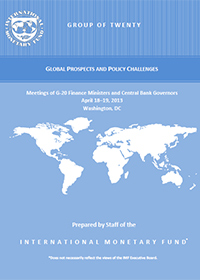Group of Twenty IMF Note-- Meetings of G-20 Finance Ministers and Central Bank Governors
IMF Note on Global Prospects and Policy Challenges
April 18–19, 2013, Washington, DC
About the Executive Summary
The Following executive summary is from a note by the Staff of the IMF prepared for the April 18–19, 2013 meetings of G-20 Finance Ministers and Central Bank Governors in Washington, DC.
Read the Full text ![]()
Executive Summary
Policy actions have reduced tail risks and financial conditions have improved. Decisive actions in the euro area and steps to avert the ―fiscal cliff‖ in the United States have contained the immediate threats to the global economy. Markets have rallied and activity has stabilized. Monetary policy continues to support demand in advanced economies, helping to offset the drag from fiscal consolidation. In many emerging economies, credit and activity are propelling each other, reflecting past policy easing and a resurgence of capital inflows.
Global activity is moving at “three speeds”. Global growth prospects are little changed—weak for some, improving or strong for others. Among advanced economies, the euro area remains stuck in low gear given the serious challenges facing EMU; and, in Japan, looking past the stimulus-driven rebound, private demand and growth are also expected to remain sluggish. In contrast, private demand and growth prospects in the United States are strengthening as public and private sector balance sheets mend. Meanwhile, growth in emerging economies is expected to be relatively strong.
While downside risks have receded some, medium-term concerns and challenges remain elevated. A stagnant euro area still faces downside risks to the short-run outlook, including reemergence of stresses if policy momentum is not sustained. In the United States, underlying momentum is being masked by fiscal consolidation; and budget sequestration, if not modified, would lower headline growth beyond this year. In the medium term, several threats loom—including more protracted economic weakness and financial fragmentation, adjustment fatigue, and stalled policy implementation in the euro area; lack of credible fiscal roadmaps in the United States and Japan; possible side effects (including spillovers) related to an extended period of monetary easing; and negative growth surprises in emerging economies.
Policymakers face a difficult balancing act in moving from stabilization to growth, but should build on recent gains to get ahead of the curve:
- Fiscal tightening must continue at a pace that the recovery can handle. Short-term adjustment must be calibrated carefully, anchored by credible and strong medium-term consolidation plans.
- Monetary policy should remain accommodative but mindful of new risks. Unconventional policies continue to provide essential support to demand and have lessened bank vulnerabilities in advanced economies. But vigilance is needed to ensure that a prolonged period of low interest rates and expanding central bank balance sheets does not give rise to fresh financial excesses. Targeted macro- and micro-prudential tools may be needed.
- Financial reform should be reinvigorated and support growth. The process remains incomplete but its pace and direction should avoid making it harder for banks to lend as the economy regains strength. Improved financial policies can also help the transmission of monetary policy.
- Emerging economies should rebuild buffers and may need to recalibrate policies. Stronger growth allows policy buffers to be gradually rebuilt over time. Policymakers must also remain alert to rising domestic financial vulnerabilities. Capital inflows may require adjustment to the policy mix.

